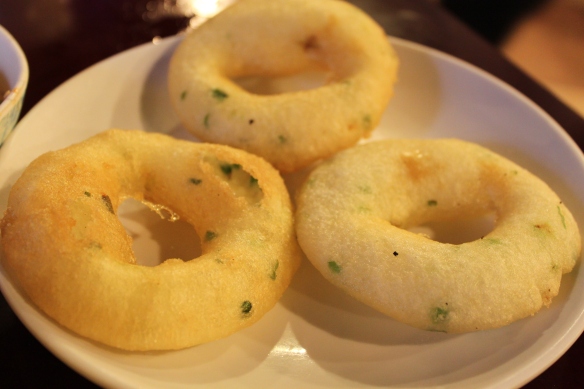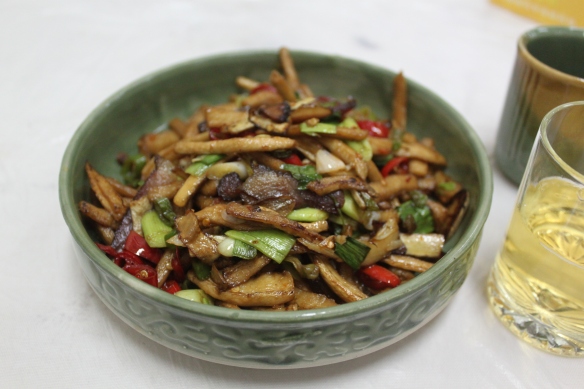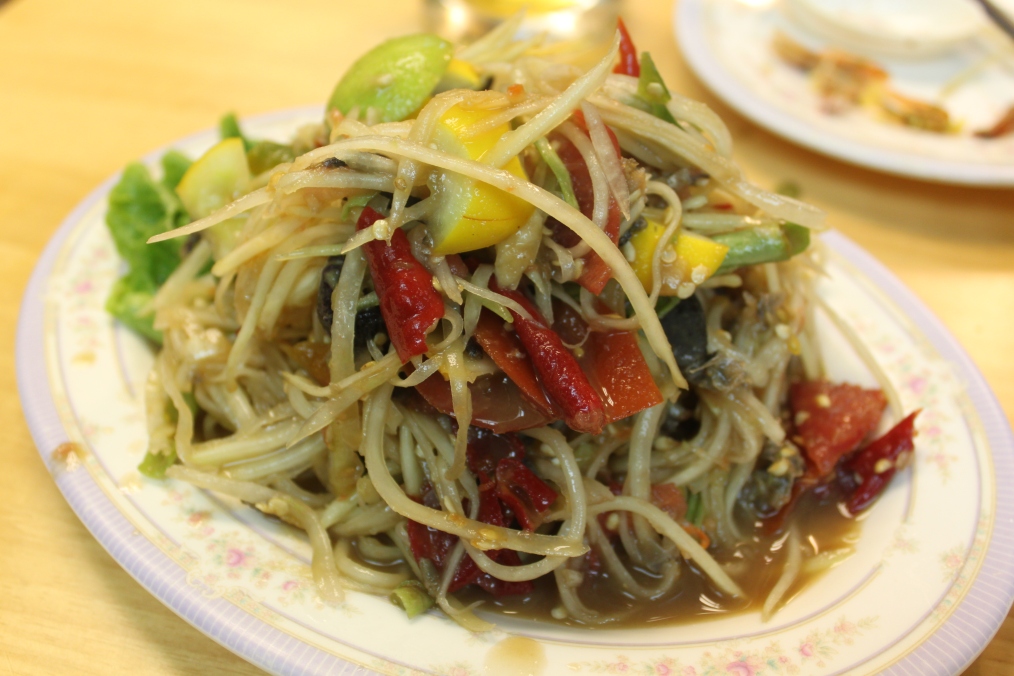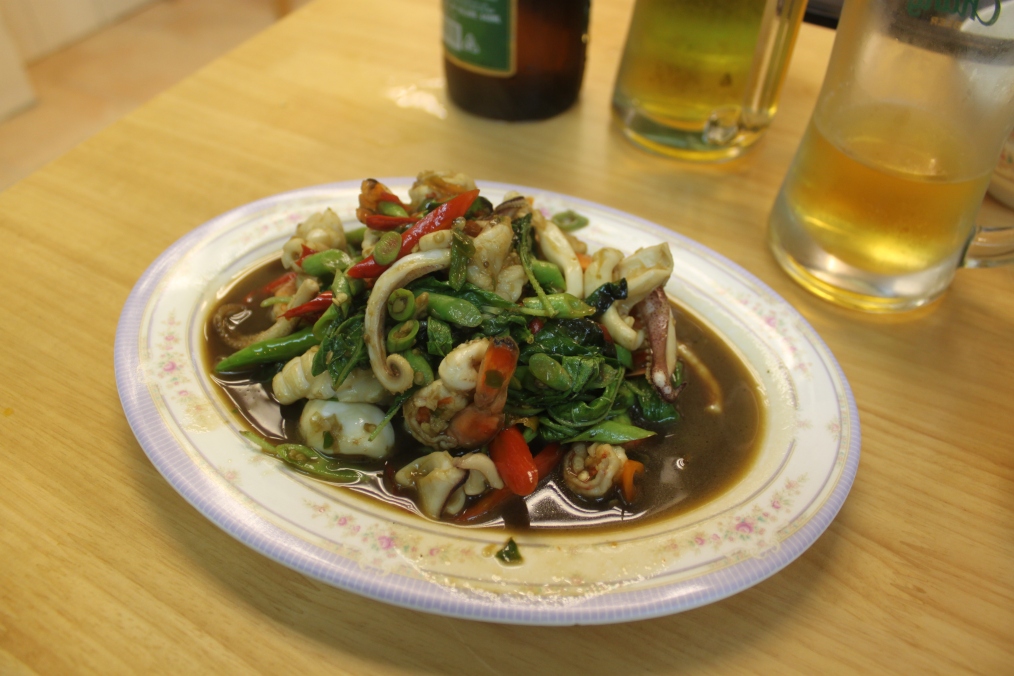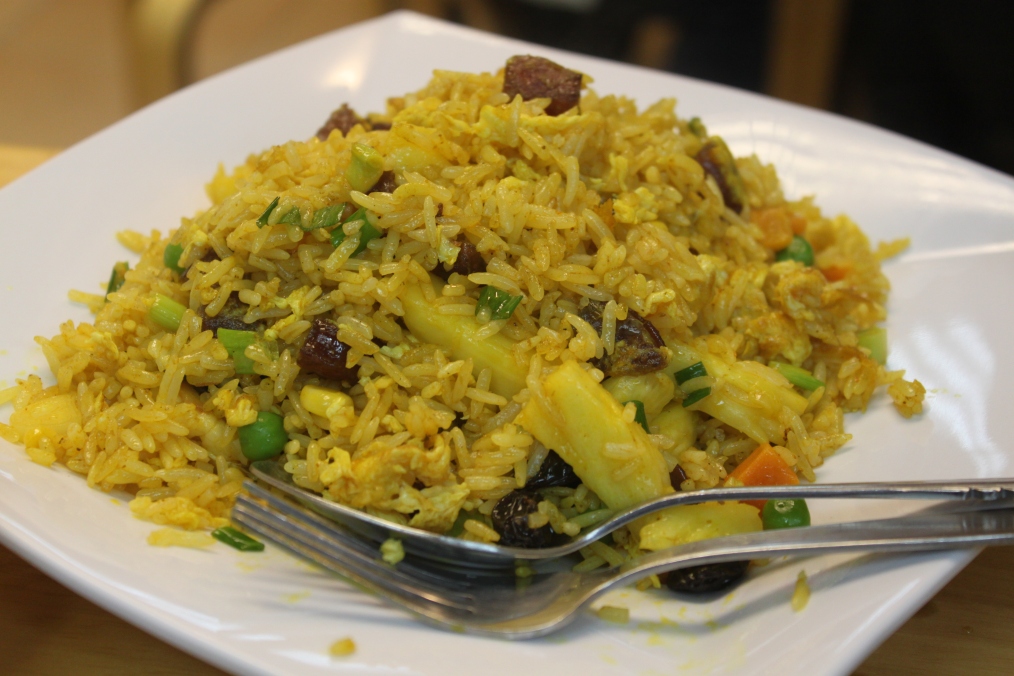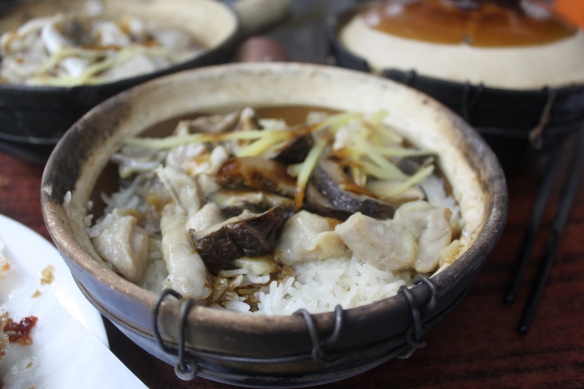Category Archives: Uncategorized
Changsha
Over the Easter weekend, I made a trip to Changsha in Hunan Province. I found it a really fantastic city with a very laid-back approach to life. Above all, the food there is amazing. There are a wealth of restaurants cooking up really distinctive Hunan dishes, and then almost every street abounds in stalls offering a really wide range of different snacks. Below is an overview of some of the places I visited – then I’ll also include links to more extensive descriptions of each one.
D-Watch Restaurant
This restaurant has a clean and super-modern interior, all cheap wood and plastic. Even the dishes the food is served on are made of plastic. But don’t let this chain cafe appearance fool you, it serves up really authentic and traditionally cooked local food that could have come from a little home style restaurant and tastes amazing. Locals pack out its many tables for this reason.
The Fifth Grandma Fermented Tofu Stall
This little tiny stall is squeezed down a small alley that dives of the western side of Huangxing South Road (a little further south than the southern end of the pedestrianised part of the street). Known as The Fifth Grandma stall, they have passed their special recipe for making the tofu down from generation to generation. The result are delicious pieces of ashy grey tofu that have a chewy outer skin and an spongy inside which oozes juices. Despite the tofo’s appearance, the flavour is quite subtle, a vinegary and smoky pungence that’s really distinctive. Also in this alley is a stall selling small snails – their springy meat soaked in a salty and spicy tasting juice.


Outdoor restaurant on corner of Xihu Rd and Huangxing South Rd
With just a few outdoor counters for a kitchen, this restaurant fries up a wide range of incredible dishes, from Hunan style frog to fried crab. One of their specialties is Kou Wei Xia (Strange Taste Fried Shrimp). Large shrimp are fried in their shells with slices of fresh red chili giving their white flesh a wonderfully sweet and spicy taste that is really special. It’s great to sit outside at one of their tables and eat this with a cold bottle of beer.
 Noodle Restaurant on Pozi St
Noodle Restaurant on Pozi St
This noodle restaurant at number 132 on the well-known snack street of Pozi Jie has minimalist no-fuss decor, just plenty of big tables to accommodate the continual flow of diners who come to eat here. It does really good bowls of Hunan style niuroufen (beef with rice noodles). The strips of meat are nice and tender, the broth has a strong meaty and earthy flavour, and each bowl is scattered with lots of fresh parsley and pieces of celery which really add to the taste of the soup.
Fire Palace, 127 Pozi Street, Tianxin, Changsha
火宫殿, 长沙坡子街号127
This restaurant is famous because Chairman Mao used to come here to eat their wide variety of delicious local snacks. The restaurant is huge, with several floors of large dining halls where the tables are all crowded with people. It’s bustling atmosphere reminded me a bit of the large dim sum restaurants in Hong Kong. As many of those used to, people here come round with trolleys from which you can pick up little dishes and baskets of snacks. There is a huge variety of things on offer – from changsha style donuts with spring onion and savory fried dough, to larger dishes like laziji and dan dan noodles.
 Yang Yanjing 杨眼镜
Yang Yanjing 杨眼镜
This restaurant is called Yang’s Glasses, supposedly because it does food so spicy that somebody called Yang lost his glasses or something. Whatever the name means, it does excellent versions of different Hunanese dishes. I had the Xiang Xi La Rou (湘西腊肉)which was wonderful, with no real sauce but great flavours and textures given by simple ingredients. Long strips of radish had a real crunchy bite to them, contrasting nicely with the soft, fatty slices of smoke meat between them . I also had 野山牛肉 (Wild Mountain Beef) which was equally good, with little tender and flavorful straggles of beef amongst some fresh red chilies giving sweet spice and some pale green pickled peppers giving a more sour pungent spice.
This restaurant is not all that easy to find. Go to the big roundabout where Lao Dong Xi Lu and South Huangxing road meet. Then walk north along the right hand side of South Huangxing road. After about 20m a small alley dives off to the right and Yang Yanjing is about half way down here. The entrance has some wooden panels and some posters of a chef frying things and is much more elaborate than the other restaurants around.
Kowloon City Thai Food
The other day I walked over to Kowloon City in search of some spicy Thai food for a story I was working on. I had hoped for something like Khao phat nam phrik narok, which translates as the evocative “rice fried with chilli paste from hell”, but it seems like none of the Thai restaurants in Hong Kong offer any of the special spicy dishes because none of their customers want them. Instead we ended up at a small cafe-style restaurant called Thai Hot, where the chatty owner promised to make us some really spicy versions of more regular dishes insisting that this would be just as hot. The papaya salad we got was really fiendishly fiery, with bits of chilli scattered through it that made my tongue burn brutally. When the waitress came over to check if it was hot enough, I was busily gulping down all the liquids on the table and could barely speak.
Hing Kee
Last night we went to Hing Kee, a much praised restaurant doing Bo Jai Faan or claypot rice that’s tucked in a grimy backstreet behind the tourist thronged Temple Street Market. The restaurant’s popularity, and the ongoing buzz about it on openrice, meant that as usual there was a long line of people waiting outside. They have a lot of tables in different shops round the area, though, so the queue moved pretty quickly.
But does Hing Kee’s food actually live up to all the hype it gets? Bo Jai Fan’s combination of rice and meat cooked in a clay pot is fairly simple, unpretentious, and hearty in style. So there’s not much a restaurant can really do to distinguish itself in terms of fancy cooking techniques or ingredients. But Hing Kee sets itself apart from other Bo Jai Fan restaurants by getting this basic combination absolutely spot on.
Our beef clay pot came with a big pile of succulent strips of beef laid on top of the rice, contrasting with a lot of restaurants which are really miserly with their meat. We broke an egg over the dish and the white soaked down into the rice, cooking as we mixed it and covering the grains with a fluffy eggy tasting coating that made the rice really hearty and heavy. This savoury egg coated rice combined well with the more juicy strips of beef mixed in with it.
Our second pot was chicken and Chinese mushrooms laid over rice. The small pieces of on the bone chicken were impressively juicy – the method of cooking perhaps allowing them to keep a lot of moisture so that they hadn’t dried out at all. The meat’s soft creaminess went well with the more earthy and fibrous texture of the dark Chinese mushrooms used.
The smoked fish and pork pot also had a nice balance of different flavours. Big pieces of silver skinned fish were laid on top of the rice. The dry, coarse flesh of this had a really striking and powerful flavour – salty and fishy and smoky all at once. Its intenseness was nicely softened, though, when eaten with a soft slice of the pork or some of the rice. Strips of ginger also added a really nice sweetness.
With all Bo Jai Fan, the rice at the bottom goes a crispy brown as it cooks against the side of the pot. It can be really nice to scrape up pieces of this crisped browned rice, that have a great crunchy taste. Here we did get some perfectly crisped rice, although some of it had also turned a little bit too black to be edible. For the clay pots to be absolutely perfect, it would be good if they weren’t burnt on the bottom at all, but that might be asking a bit too much.
Along with the clay pots we also had ho beng, or deep fried oyster omelette. This was perfect. In some restaurant’s the omelette is too thick and just the outside is fried and crispy, leaving a stodgy mess of uncooked egg and oyster inside. But here the tangled strands of egg were all nicely crisp and brown with just a thin layer of soft egg in the middle. Often I also find places use too many oysters, so these completely overpower things, but here they were nicely restrained, with just a few of the juicy oyster held in the crispy casing and plenty of spring onion mixed in too. Added to this, the omelette was really dry and crisp, with none of the soggy oiliness that some can have. It had clearly just been made and tasted fantastic.
So overall, I would say that Hing Kee definitely lives up to the praise it’s been given and is well worth the half hour or so you’ll have to wait. While other restaurants around do also serve fairly decent bo jai fan, many of them slip up on a few elements of the dish, while here you can enjoy clay pots that are almost exactly the way they should be.
Directions
Look It Up

What are cheungfan? What does hing taste like? And what are bhindi? If you’re anything like me then I’m sure there are times when you’re left a little lost by the foreign words on menus, or bewildered by ingredients in a recipe. Wouldn’t it be great if somebody could create searchable online dictionary of different ingredients from around the world?
Well that’s exactly what Suzy Oakes did at www.whatamieating.com. This fantastic foodies’ resource is a dictionary of ingredients with more than 65,296 entries in over 303 languages. Sadly, Oakes died earlier this year and so the project remains unfinished. But even as it is, this is a really brilliant aid for anybody keen on exploring food.
Kathmandu
About
I was excited to spot this place hidden in the back streets below the hulk of The Belchers. Hong Kong has so few Nepalese places that it’s always good to have another one, plus the humble front of this place made me optimistic it might be reasonably authentic.
But things quickly began to disappoint. First, I noticed they offered Spanish Tapas alongside Nepalese food in what I could only take as an attempt to cash in on two markets. Then, the menu felt disappointingly limited. Instead of offering something distinctly Nepalese, most of the dishes resembled those served in India restaurants across town, and the more standard dishes offered by these places at that. There were korma and jal-frezi curries, a few tandori dishes, but nothing much else.
We went for a Kathmandu fish curry with mustard seeds, which looked like one of the more unusual things on the menu. It shared a problem suffered by most of the fish curries I’ve had, the delicate taste of the soft white fish becoming completely lost in the sauce. Instead of cheap white fish, it would be nice to see curries made with something slightly meatier. The curry’s sauce wasn’t bad, tasting convincingly rich and thick, with the mustard seeds adding a nice hint. However it lacked the subtle hints of spice and feeling of balance that have made curries I’ve had before really stand out. The small metal dish of curry we were given also felt very small, especially considering that it cost around HK$80.
The mixed tandoori was also distinguished primarily by its size. It was about half as big as similar dishes offered in other restaurants and really felt insubstantial considering the HK$100 price tag. The small pieces of sausage tasted good, with mixed lamb nicely blended with herbs, but their flavour didn’t really compensate for their measly size. The ostrich meat, the one slightly more unusual part of this mix, was very tough and uninspiring. Better Tandoori can definitely be found at some of the restaurants in Chungking.
The samosas we had to try and supplement these shrunken portions were also on the small side. They tasted very dry – as though frozen or made a long time ago – and had been reheated quickly (maybe microwaved) so that the insides were still lukewarm. They were a depressingly long way from the crisp, slightly flaky-shelled, Samosas that you can get just fried on the streets of India. You can also pick up much better samosas for about a third of the price just by wandering around Chungking mansions.
We also had some Nepalese Ghurka beer (HK32), which came in small bottles and was very watery and lacking in flavour. I switched across to something else after my first glass.
My biggest complaint about Kathmandu is the price of the dishes, which mostly sat between HK$80 and $100. This might be justified if these are for huge, or even normal sized, portions, but for the shrunken serving we seemed to get it felt too much. Equally, it might be okay if the restaurant was producing some really outstanding cooking. I will happily pay for tiny servings of really great Japanese food, for example. But the food here was largely very mediocre. I don’t think I will return.
Directions
G/F. Shop 1A, Woo Hop St, South Lane, Kennedy Town (At the back of The Belcher’s)
Raku-En
About
I’m writing this quite a while after going to Raku-en and am not able to remember too much detail about the separate dishes we had. But the quality of the Okinawan food offered here made me want to write at least a short listing to be updated on a second visit.
Hidden away at the top of a tower, this place specialising in Okinawa style Japanese food felt authentic the moment we stepped in. Japanese magazines and other items crowded the front counter, sake bottles lined the walls, and all the tables were already filled by excited groups of young Japanese. It’s one of several Causeway Bay based hideaways for Hong Kong’s Japanese community.
The menu had a massive range of small plate dishes ranging from about HK$40 to 70. I am fairly new to Okinawan food, so was fairly bewildered a choice of dishes that stretched from stuffed fried chicken wings all the way to snapper carpaccio.
The pork belly in miso had beautifully soft pieces of meat which melted in your mouth, their small layers of fat adding a richer buttery hint to the taste. Each spongy piece has soaked up the sauces stronger flavours and let these drift sumptuously out as you chewed.
Fried chicken sunk into a pile of crumbled bread and garlic and chilli also tasted great. Each crisp piece of chicken would gather up so of this pile to add to the crisp flavour of the skin. Both this, and the skewers, were ‘snack style’ dishes prepared excellently and with extra elements.
The stuffed chicken wings were another example of this. With the bones taken from the middle of the meat, little fleshy white pockets were filled with a pasty stuffing. This was sealed in a wonderfully crisp skin that was perfectly fried to fill it with taste whilst keeping it from being to charred or oily.
Almost all of the other dishes we had followed a similar trend – full of flavour and with meticulous attention to detail. The cod showcased as well as anywhere I have been in Hong Kong the Japanese ability to prepare fish in a very simple way that brings out all of its flavours.
Overall, Ruku-en is a great place to go to explore Okinawan cuisine and to try a wide range of different dishes. I felt confident that the things I was eating were genuine and that whatever I ordered it would be well prepared and offer something interesting.
Directions
12 F Circle Tower, 28 Tung Lung Street, Causeway Bay
Website
Cost
About $40 to $80 per dish.
Pho 26
About
I had walked part this place many times and hadn’t really expected much from it. But it turned out to have some of the best Pho I’ve had in Hong Kong, full of the strong fresh flavours which make the dish so special.
I believe that Pho should come overloaded with herbs and the version here didn’t disappoint. The noodles came with a huge pile of herbs and spring onion laid above the noodles. These slowly sank down into the broth giving it a really intense, earthy basil flavour that is so different from the water soup you get in a lot of places. There were also big clumps of lemongrass that added an extra, especially pleasing freshness and gave the broth more distinctiveness.
Some people might complain about the fact that this many herbs makes it harder to eat the noodles, but I’d much rather have this than loose all the flavour the herbs give. The pho perhaps could have done with a few more noodles in, but there was definitely enough to make is a satisfying porting. It also had a fairly generous amount of beef which, although not as tender as it could have been, wasn’t at all chewy like in some restaurants.
You can also get the special Kobe beef pho for $52 and a tomato sauce pho. Alongside these things, the restaurant has a pretty good selection of other Vietnamese dishes, like spring rolls and milk buns.
You can read another review here.
Directions
302 Queens Road Central, Sheung Wan
Cost
Pho about HK$30
Chili Fagara

Entrance to Chili Fagara - Form Over Function?
About
I apologise to anyone expecting a real review of this place. I didn’t actually eat there.
Because the restaurant was full, we were brusquely ushered to a table right in front of the door. I was given a couple of menus, covered in finely embroidered Chinese style cloth. I looked down the list of items, fairly standard Sichuan things given elaborateness in their English translations.
Then I saw the prices! Dan dan mihn was about $98, while a lot of the other dishes were way up about the $100 mark. These were ordinary dishes – some the more ‘special’ things were even higher up the scale. I began evaluating whether it was still worth staying to try this place. I realised that for the price of two or three dishes here I could be having a nine course Sichuan meal at Mum Chau’s or a feast of food at Sijji.
These dishes would have to be really good to make it worth such prices. I looked around at what other people had, glimpsing small bowls and fancy cutlery, and wasn’t convinced. So I did something I very rarely do. Stood up and left. After we got out, my Japanese friend asked me why I’d wanted to leave so much.
“Too expensive,” I said, “Dan dan mihn for $100”
He laughed and, being an ex-food exporter, did some sums out loud. “Yeah, noodles only cost $4 and meat maybe $10, and vegetables $5, so where’s the extra 81?
Instead, we wandered down the hill to one of the dai paai dongs on Graham Street and ordered a feast of different freshly made dishes, none of which cost more than $40. I sat as the rain tumbled down outside the umbrella, enjoying this food and authentic Hong Kong atmosphere.
I’ll go back to Chilli Fagara sometime, to see if it really justifies such extravagant prices. But for now, I’m glad I walked out.
Directions
G/F, 51A Graham Street, Central District, Hong Kong
Notes
Tel: 28933330
Khyber Pass Indian Mess House

Mutton Saag, Mutton Jal Frezi and Chicken Mahkani
About
Getting good Indian food in Hong Kong is not easy. If you go to most of the places on the island you’re likely to be dissapointed by half hearted, almost bland, attempts at different curries and preheated onion bhajis. A much better bet is to head over to Chungking Mansions which clusters a lot of the local India community and promises a much more authentic experience.
Khyber Pass has for a long time been my pick of the different offerings in the mansion. When I visited several years ago, Khyber Pass offered curries cooked so that their different flavours were more intense, a wider range of different types of dishes and breads, and a generally more pleasant atmosphere.
The balance of spices in the sauces at Khyber is its main strength, although the tandori dishes are also supposed to be good. The saag curries have spinach potent in flavour with a nice course texture that goes best with tender white chunks of chicken. We had the mutton saag however, and the sauce was let down by large chunks of lamb that were tastless and far too tough.
Mutton jalfrezi suffered from the same poor quality meat. Really the lamb should break apart into soft chunks. The jal frezi also lacked that slight piquancy which can make jal frezi so interesting. It had nicely balanced spices, but didn’t really leave you with a striking impression. The chicken mahkani was good however, with the really rich, subtly spice creaminess which makes this dish so satifying.
Several other smaller complaints might further push me to look elsewhere. The popadoms came with tomato sauce. The waitress who took our order didn’t really listen properly and kept suggesting different things in an attempt to push the price up. The restaurant now serves alcohol and although the didn’t make a fuss about us drinking our own bottles, indicated that this was unwelcome in future. Other restaurants in Chungking allow you to bring your own.
Directions
Chungking Mansions is located 36-44 Nathan Road. Entering the building from Nathan Road, you need to head to the back right hand elevator, and then go to the 7th floor. Alternatively if you ask the guys loitering out the front of the building, the chances are one of them will be eager to lead you to Khyber Pass and also to give you a 10% discount card.






